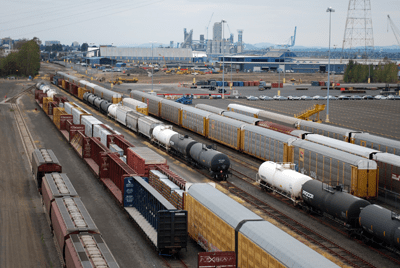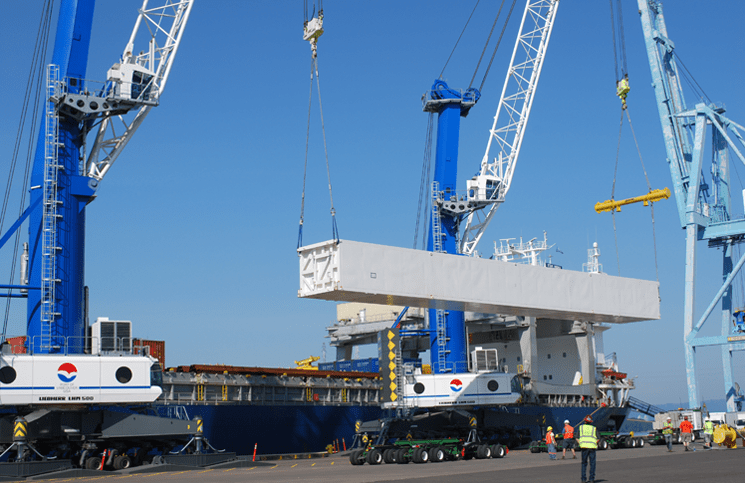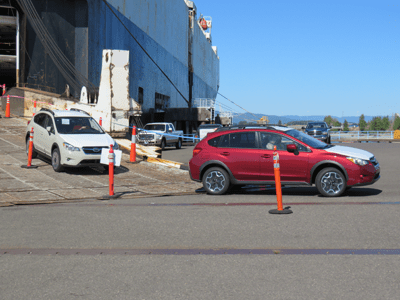“We’re coming off our best year in our 103-year history.”
That statement by Alastair Smith, chief marketing and sales officer at the Port of Vancouver, embodies the spirit of excitement and opportunity that pervades the port’s staff. In 2014, the port handled the most tonnage ever – 6.6 million metric tons (a 47 percent increase over 2013) – and generated $37.5 million in operating revenue (a 25 percent increase over 2013). Significant increases in grain exports and steel and wind energy imports formed the foundation of the record-setting year, with 35 percent more vessels and 23 percent more rail cars moving cargo to and from the port in 2014. Steel volume alone increased 495 percent. More than 56,000 rail cars moved through the port last year, thanks to increased rail capacity from the port’s West Vancouver Freight Access project.
While these numbers are impressive, the economic impact behind them is even more so. More than 2,300 people are directly employed by port tenants, while port activities generate $1.6 billion in economic benefit to the region and support almost 17,000 jobs throughout the community. The port itself recently added about 20 new employees, bringing the total to 120.
“We’re getting busier,” said Smith. “We need staff to handle that. Plus, we’re looking at growing in different directions, and increasing our footprint in the industrial sector and on the waterfront.”
 But the port is more than just numbers; it’s cranes and ships, and trains and trucks; it’s roasted malt that’s used in the microbrew you had last night; it’s fertilizer and wheat, and so much more. A virtual tour will help bring the port to life.
But the port is more than just numbers; it’s cranes and ships, and trains and trucks; it’s roasted malt that’s used in the microbrew you had last night; it’s fertilizer and wheat, and so much more. A virtual tour will help bring the port to life.
Terminal One
This is where it all started over 100 years ago – the beams you see in the Red Lion at the Quay came from the port’s original warehouse. Today, Pacific Coast Shredding (which handles about 500,000 tons of scrap metal annually), Northwest Packing Co., Great Western Malting Co. and United Grain Corp. are the tenants here. Northwest Packing recently renewed their lease for another 10 years. United Grain (whose grain elevator was built in 1934) handles 16 percent of U.S. wheat exports and has responded to global market demands by expanding their silo capacity to handle more soybeans and corn – increasing their throughput from 3.1 million tons to 5.5 million.
Terminal Two
This is where you’ll find the port’s two mobile harbor cranes – each sporting 80 rubber tires – busy loading and unloading heavy cargo such as wind energy components (these can be 130 feet long and weigh 100 tons) or several slabs of steel in one bite. The port was the first on the West Coast to purchase such cranes (one in 2006 and the second in 2008), and the first to train operators in the complex choreography of tandem and engineered lifts.
“It was a niche [for a long time],” said Smith. “Now people are copying us.”
Because the cranes can carry more than a standard crane, they help lower the cost of handling the bulk exports that travel through this terminal.
NuStar Energy Inc. is an example of how versatile the port is, handling commodities ranging from fertilizer and sodium hydroxide to jet fuel and methanol.
Terminal Three
Wood pulp, steel, lumber and other non-containerized commodities pass through the 600,000 square feet of warehouse space at this terminal. For example, tissue paper from Brazilian eucalyptus trees finds its way from the port into cigarette filters, racing tires and – I’m not making this up – Italian ice cream, as filler.
Subaru of America Inc. shipped 81,000 cars through this terminal in 2014, and projections call for 90,000 in 2015. July was a record-breaking month, with 10,000-plus vehicles crossing the causeway.
“Subaru has been a fantastic tenant for us,” Smith stated. “They just signed a 2030 lease extension.”
Terminal Five
The pending Vancouver Energy Project has captured a lot of attention at this terminal and the BHP Billiton project has been postponed indefinitely. But Smith was optimistic about other opportunities, such as bulk export/import, autos, or energy – perhaps wind energy or handling the pipe used in liquid natural gas projects from Canada.
More on the horizon
“We need to create more land,” Smith stated flatly. “People are screaming for industrial spaces.”
The port has several projects in various stages of completion. Columbia Gateway is an as-yet undeveloped 530 acres with a mile of waterfrontage and deep water access. Smith said that auto import would be a good fit. It’s the largest contiguous tract of undeveloped industrial property in Southwest Washington. Centennial Industrial Park, located just across Lower River Road from the port’s administrative offices, will soon be home to Sunlight Supply’s new 285,000-square-foot headquarters, with ground breaking before the end of October. The port is considering constructing a 100,000- to 120,000-square-foot warehouse on the same parcel, and already has a request for a pre-lease agreement. The port is also considering purchasing industrial property in mid-county.
“Once we’re full down here,” said Smith, “where do we go?”
Another exciting opportunity is the Legacy Waterfront Project. The port intends to revitalize its acreage at Terminal One – but exactly what form that will take is not yet clear. Smith said they were hiring a consultant to determine the preferred alternative to present to the port commissioners this month. Options include various combinations of office space, a new hotel, retail and residential.
Challenges– or opportunities
It’s not easy keeping a port the size of Vancouver’s running smoothly. Just the sheer number of tenants (more than 50) and the seemingly never-ending need to expand rail capacity raise logistical issues. In the next few months, the port plans to move the dump pit for Kinder Morgan Bulk Terminals Inc., as well as demolish an office building and a stevedore locker to make room for more track.
“It’s a big jigsaw puzzle,” Smith said.
Other challenges come on the heels of decisions made far away. For example, without subsidies on wind energy, the port has had very little wind energy business this year. Sanctions on imported new steel have caused seven countries to discontinue shipping steel through the port.
“It’s hard,” said Smith, “when the U.S. Department of Commerce blows up all your marketing. This will affect our budget going forward.”
Other countries’ economics can also significantly impact the port, such as a 74 percent drop in China’s demand for copper concentrate.
But perhaps the biggest challenge, Smith said, is in “where to put our money. There’s $80 million in need, but only $30 million available. There’s a lot of opportunities to filter through.”
WHAT’S THE PORT MADE OF?
- Third-oldest port in Washington
- 99.3 percent industrial occupancy rate
- 2,127 acres of property and four miles of waterfrontage
- 58 acres of development-ready property
- Two million square feet of industrial warehousing
- Five marine terminals with 13 shipping berths serving 12 shipping lines
SEE FOR YOURSELF
There’s no better way to grasp the scope and impact of the Port of Vancouver than by personally experiencing it. The port offers free two-hour public tours several times throughout the year.
“I haven’t met a single person who has toured the port that hasn’t said ‘Wow – I had no idea!’,” said Magan Reed, communications coordinator for the Port of Vancouver.
The tours are “family friendly,” and you can call 360.693.3611 for more information.




